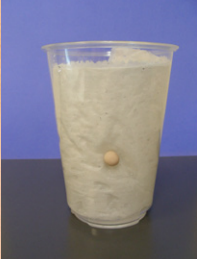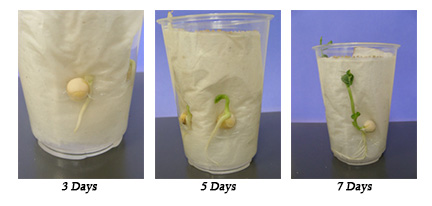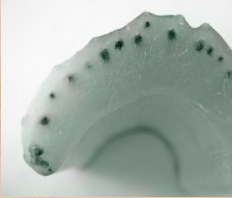Agricultural Literacy Curriculum Matrix
Lesson Plan
Plant-Soil Interactions (Grades 3-5)
Grade Level
3 - 5
Purpose
Students discover how plants and soils interact by observing root growth, considering the function of a plant’s roots, modeling the movement of water into the roots, and investigating the movement of water and nutrients throughout the plant. Grades 3-5
Estimated Time
Three 45-minute class periods plus observation time
Materials Needed
Activity 1: How Does a Plant Grow?
- Clear plastic cup, 1 per student
- Paper towels, 1 per student
- Pea seeds, 2-3 per student
- Permanent markers
Activity 2: From Soil to Roots
- Seedling from Activity 1
- Hand lens, 1 per group
- Paper or styrofoam cup
- Large container
- Bottle of food coloring
- Sharp pencil
Activity 3: From Roots to the Plant
- Master 3.1
- Sharp knife (for the teacher)
- Paper or styrofoam cup, 1 per group
- Celery stalk pieces (approximately 2 inches), 1 per group
- Bottle of food coloring, 1 per group
Vocabulary
crop: a cultivated plant that is grown and harvested, especially a grain, fruit, or vegetable
permeability: the ability of soil to allow the passage of water
Background Agricultural Connections
After completing this lesson, students will be able to:
- Define “nutrient;”
- Recognize that plants remove water and nutrients from the soil through their roots; and
- Explain how a plant’s roots and vascular system function.
View the Plant-Soil Interactions Lesson Video to obtain background information for the lesson.
This lesson is one of a five part series. See the following titles for related lessons:
- Plants Around You: Students learn about the functions of plant parts and the environment plants need to grow.
- Properties of Soil: Students learn about the characteristics and components of soil.
- Plant-Soil Interactions: Students learn about the function of roots and how water and nutrients move through the plant.
- Plant Growth Affects the Soil: Students learn about how plant growth takes nutrients from soil and how nutrients can be replaced.
- How Does Your Garden Grow?: Students make a plan for a garden.
Engage
- Ask the students the following questions to introduce the lesson:
- How do plants take in water and nutrients from the soil?
- How does water and nutrients get from the roots to the rest of the plant?
- Can a plant circulate water and nutrients through the roots, stem, and leaves just like a human's circulatory system circulates blood and nutrients?
Explore and Explain
Activity 1: How Does a Plant Grow?
- Inform the students that they will be looking at the growth of pea seeds over the next few days. Model for the students how to set up the pea seeds in a cup with a paper towel and water. Note: This set up will need to be done several days before students begin with Activity 2.

- Write your name near the top of the cup using a permanent marker.
- Fold the paper towel and place it into the clear plastic cup so that it lies against the walls of the cup and does not extend above the rim of the cup.
- Use a spray bottle to moisten the paper towel.
- Insert 2-3 pea seeds between the paper towel and the wall of the cup. The seeds should be placed evenly around the cup and about 1/3 of the way from the bottom of the cup.
- Add water to the cup. The seeds should not be submerged in water—the paper towel will wick water to keep the seeds moist.
- Add water periodically so that the paper towel and seeds do not dry out.
- For the next few days, allow a few minutes for students to observe their pea seeds.
- After students begin to observe changes or growth in their seeds, ask students to share their observations. Record the observations on the board or chart paper. Continue to add to this list for a few days. Observations may include:
- The seed swells or gets larger
- The root grows downward
- Branching of the root system
- A green stem growing upward
- Small leaves on the stem

Activity 2: From Soil to Roots
- Ask the students, “Why do plants need water from the soil?” Follow this with the question, “Is there anything else in the water that the plant needs?”
- Introduce the word “nutrients” to the students. Nutrients are substances that plants and animals need to be healthy. Nutrients cannot be seen, but are important for health. The nutrients plants need are released from soil particles into soil water.
- Continue the discussion by asking students how plants get their nutrients, "What parts of the plant are important for getting nutrients from the soil?" (roots)
- Explain to the students that they will be examining the roots of a plant. Divide the students into groups of four. Pass out a young seedling (taken from the paper towel germination in Activity 1) and a hand lens to each group. Tell the students that they should look at the roots of the seedling first using just their eyes and then using the hand lens. Ask the students to draw a picture of the roots of their seedling. Note: When students look at the roots with just their eyes, they may see just a basic root structure. When they use the hand lens, they are likely to notice small, fine projections coming off the roots. These are the root hairs. The root hairs are white and very fine. It may be easier to see the root hairs if students put a dark background behind the roots.
- After the students have drawn pictures to represent their observations, ask for volunteers to describe what they saw. Students can also compare their observations with the seedlings from Activity 1.
- Ask students, “Why do you think plants have so many root branches and root hairs?” (More root hairs allow for more area with which to contact water and nutrients in the soil.)
- Ask students, “How do nutrients in the soil water get into the root hairs?”
- Explain to the students that you are going to demonstrate the process by which water enters the roots. As you lead the demonstration, explain that the cup represents the root, the water inside the cup represents the water inside the root, the water in the larger container represents the water in the soil, and the food coloring represents the nutrients dissolved in the water.
- Step 1: Fill the cup about half full of water.
- Step 2: Place the cup of water into the center of the larger container.
- Step 3: Fill the larger container with water until its level is the same as that in the cup.
- Step 4: Add several drops of food coloring to the water in the larger container and gently mix the water until the color is evenly distributed through the water. Do not add food coloring to the water in the cup!
- Step 5: Using a sharp pencil, poke two small holes in the cup opposite each other.
- Step 6: Watch the water in the cup for up to five minutes.
- Ask the students to share their observations from the demonstration.
- Ask the students, "How is the demonstration similar to what happens in the roots of plants?" (The demonstration is a model of how water and nutrients move from outside the root to inside the root.)

Activity 3: From Roots to the Plant
- Ask the students, “Besides the roots, do other plant parts need water and nutrients?” followed by “How do water and nutrients get from the roots to the rest of the plant?”
- Explain to the students that they are going to investigate how water moves from the roots to the rest of the plant. Ask the students to work in their groups of four from Activity 2.
- Pass out a copy of Master 3.1 to each student. Read through the instructions with the students to ensure that they understand their task.
- Ask the students to write their predictions about what will happen with the food coloring, water, and celery.

- As the students work on their investigation, circulate among the groups to answer questions and help them with timing the investigation.
- Reconvene the class and ask for volunteers to report their predictions and results about the movement of the food coloring in the celery. Ask them if their predictions were correct or incorrect. Ask them what conclusions they can make about the movement of water and nutrients in plants. (The food coloring was transported up the celery stalk and was visible as a series of colored dots along the top of the stalk.)
Elaborate
-
Use carnations to show how water is transported throughout a plant. Cut the carnation stem diagonally so that the stem is about 6" (15.24 cm) long. Add six drops of food coloring into 2" (5.08 cm) of water, and place the stem of a carnation into the colored water. Within two hours, small colored areas will appear at the edges of the petals.
Evaluate
After conducting these activities, review and summarize the following key concepts:
- Water and nutrients are located in the soil.
- Plants absorb water and nutrients from the soil to their roots. This process removes nutrients from the soil.
- Water and nutrients are circulated through the plant's vascular system.
Acknowledgements
- BSCS-Biological Science Curriculum Study
- Reviewed by Smithsonian Institution
Recommended Companion Resources
- Is There Ever Too Much of a Good Thing?
- Nutrients for Life eLessons
- What Do Plants Need to Grow?
- How Things Grow
- The Dirt Book: Poems About Animals That Live Beneath Our Feet
- The Great American Dust Bowl
- Under Your Feet: Soil, Sand and Everything Underground
- 4R Reader
- SOIL Reader
- Soil Health Education Resources
- Soil Life
- Soil Science Society of America
Author
Nutrients for Life Foundation
Organization
Nutrients for Life Foundation
| We welcome your feedback! If you have a question about this lesson or would like to report a broken link, please send us an email at matrixelearning@gmail.com. If you have used this lesson and are willing to share your experience, we will provide you with a coupon code for 10% off your next purchase at AgClassroomStore. |
